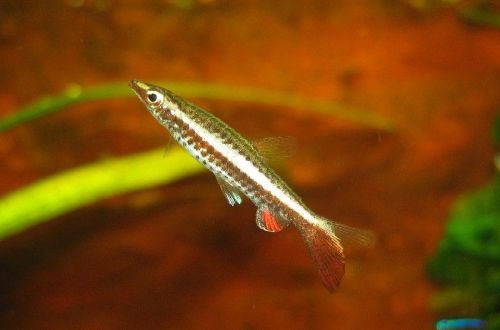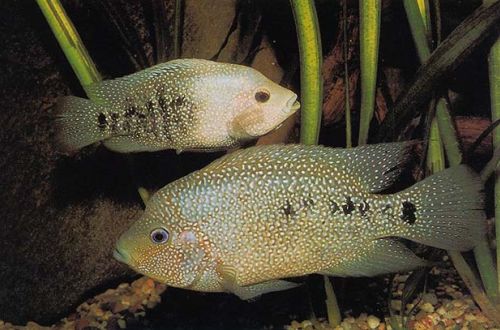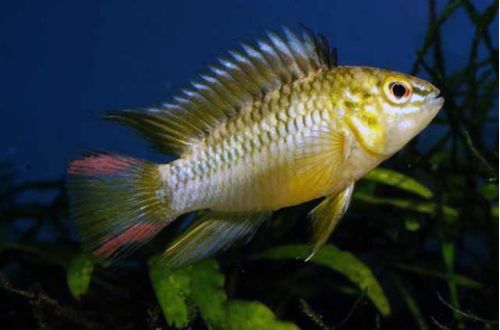
Pecilobrycon
Pecilobrycon, scientific name Nannostomus eques, belongs to the Lebiasinidae family. An unusual curious fish, which is interesting to watch. An amazing ability is the change in body pattern depending on the lighting, as well as the original oblique swimming style. Suitable for most tropical aquariums, however, it is demanding in terms of conditions and cannot be recommended for beginner aquarists.

Habitat
Widespread in the upper part of the Amazon (South America) in the area where the borders of Brazil, Peru and Colombia converge. They live in small rivers and their tributaries with a weak current, in flooded areas of the forest in places with dense vegetation and fallen leaves.
Description
A low elongated body with a pointed head, a small adipose fin. Males are somewhat slimmer than females. The coloration is gray-brownish with a dark longitudinal stripe in the lower part of the body. In the dark, the color of this fish changes. Instead of a longitudinal dark stripe, several oblique stripes appear. The anal fin is red.
Food
Any small food can be fed both dry packaged (flakes, granules) and live (bloodworm, daphnia, nauplii). The main requirement is small particles of feed. If dry food is served, protein supplements must be present in the composition.
Maintenance and care
A small aquarium with areas of dense vegetation and a few groups of floating plants is sufficient. As shelters, snags, intertwined tree roots, branches are used. The substrate is any dark with a few dry tree leaves. They will color the water a natural brownish tint, replace weekly.
Pecilobrikon is very picky about the quality and composition of water. It is necessary to provide soft slightly acidic water. In view of its periodic renewal by 20–25%, the best way to treat water is to use special reagents to change the pH and dH parameters, as well as water test kits (usually litmus papers). Sold in pet stores or online. Cleaning the soil with a siphon from waste and debris once a week during the renewal of water.
In the equipment, the main role is given to the filtration system, based on financial capabilities, select the most efficient filter with peat-based filter material. Thus, not only water purification is achieved, but also a decrease in the pH level below 7.0. other equipment consists of heater, lighting system and aerator.
Behavior
Peaceful schooling fish must be kept at least 10 individuals. Due to their modest size, only small calm fish are suitable as neighbors. Any large species, especially aggressive ones, are unacceptable.
Breeding / breeding
Breeding in a home aquarium is relatively simple. Fish attach eggs to the inner surface of the leaves of rooting plants, such as Anubias dwarf or Echinodorus Schlüter. There is no parental care for the offspring, so the eggs can be eaten by the neighbors in the aquarium and the parents themselves.
It is recommended to use a separate tank, a kind of spawning aquarium, where plants with eggs on them will be placed. The water parameters must fully correspond to the parameters from the general aquarium.
The creation of special conditions is not required, an additional incentive is the inclusion of live food in the daily diet. When you notice that one of the fish (female) has become noticeably larger, the abdomen has rounded, then spawning will begin soon. It may not be possible to catch the process itself, so check the leaves of plants daily for the presence of eggs in order to place them in a separate tank in a timely manner.
The fry appear after 24–36 hours, and begin to swim freely on the 5th–6th day. Feed micro food powdered into dry flakes or granules.





